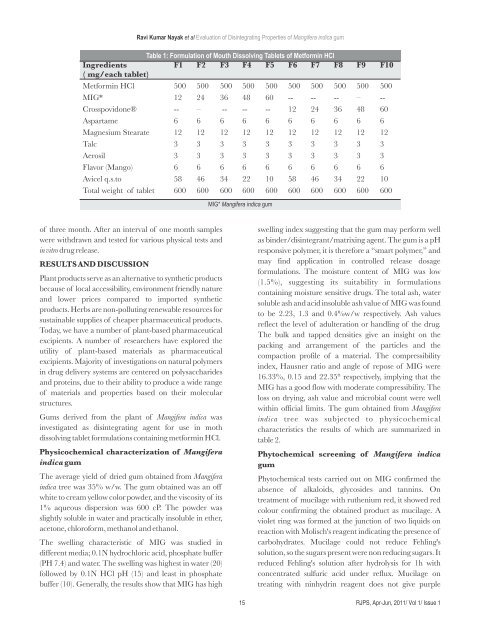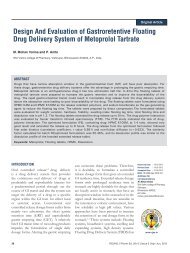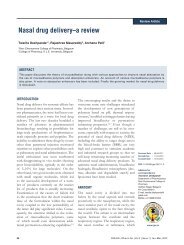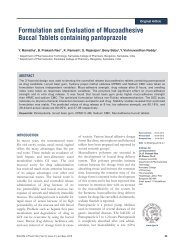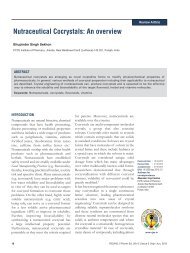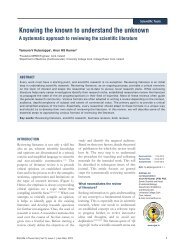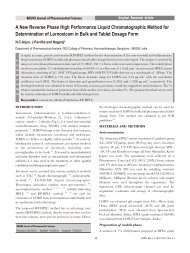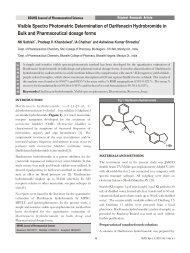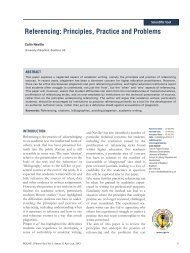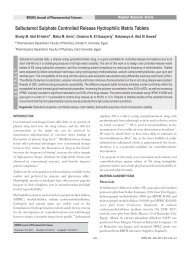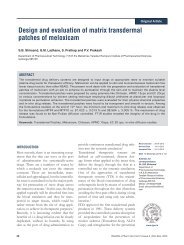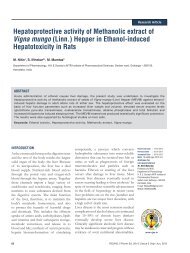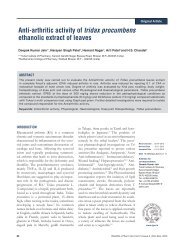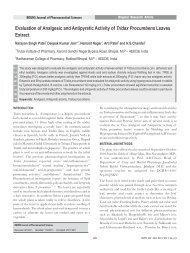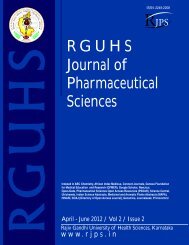final .cdr
final .cdr
final .cdr
Create successful ePaper yourself
Turn your PDF publications into a flip-book with our unique Google optimized e-Paper software.
of three month. After an interval of one month samples<br />
were withdrawn and tested for various physical tests and<br />
in vitro drug release.<br />
RESULTS AND DISCUSSION<br />
Plant products serve as an alternative to synthetic products<br />
because of local accessibility, environment friendly nature<br />
and lower prices compared to imported synthetic<br />
products. Herbs are non-polluting renewable resources for<br />
sustainable supplies of cheaper pharmaceutical products.<br />
Today, we have a number of plant-based pharmaceutical<br />
excipients. A number of researchers have explored the<br />
utility of plant-based materials as pharmaceutical<br />
excipients. Majority of investigations on natural polymers<br />
in drug delivery systems are centered on polysaccharides<br />
and proteins, due to their ability to produce a wide range<br />
of materials and properties based on their molecular<br />
structures.<br />
Gums derived from the plant of Mangifera indica was<br />
investigated as disintegrating agent for use in moth<br />
dissolving tablet formulations containing metformin HCl.<br />
Physicochemical characterization of Mangifera<br />
indica gum<br />
The average yield of dried gum obtained from Mangifera<br />
indica tree was 35% w/w. The gum obtained was an off<br />
white to cream yellow color powder, and the viscosity of its<br />
1% aqueous dispersion was 600 cP. The powder was<br />
slightly soluble in water and practically insoluble in ether,<br />
acetone, chloroform, methanol and ethanol.<br />
The swelling characteristic of MIG was studied in<br />
different media; 0.1N hydrochloric acid, phosphate buffer<br />
(PH 7.4) and water. The swelling was highest in water (20)<br />
followed by 0.1N HCl pH (15) and least in phosphate<br />
buffer (10). Generally, the results show that MIG has high<br />
Ravi Kumar Nayak et al Evaluation of Disintegrating Properties of Mangifera indica gum<br />
Table 1: Formulation of Mouth Dissolving Tablets of Metformin HCl<br />
Ingredients<br />
( mg/each tablet)<br />
F1 F2 F3 F4 F5 F6 F7 F8 F9 F10<br />
Metformin HCl 500 500 500 500 500 500 500 500 500 500<br />
MIG* 12 24 36 48 60 -- -- -- – --<br />
Crosspovidone® -- – -- -- -- 12 24 36 48 60<br />
Aspartame 6 6 6 6 6 6 6 6 6 6<br />
Magnesium Stearate 12 12 12 12 12 12 12 12 12 12<br />
Talc 3 3 3 3 3 3 3 3 3 3<br />
Aerosil 3 3 3 3 3 3 3 3 3 3<br />
Flavor (Mango) 6 6 6 6 6 6 6 6 6 6<br />
Avicel q.s.to 58 46 34 22 10 58 46 34 22 10<br />
Total weight of tablet 600 600 600 600 600 600 600 600 600 600<br />
MIG* Mangifera indica gum<br />
15<br />
swelling index suggesting that the gum may perform well<br />
as binder/disintegrant/matrixing agent. The gum is a pH<br />
responsive polymer, it is therefore a “smart polymer,” and<br />
may find application in controlled release dosage<br />
formulations. The moisture content of MIG was low<br />
(1.5%), suggesting its suitability in formulations<br />
containing moisture sensitive drugs. The total ash, water<br />
soluble ash and acid insoluble ash value of MIG was found<br />
to be 2.23, 1.3 and 0.4%w/w respectively. Ash values<br />
reflect the level of adulteration or handling of the drug.<br />
The bulk and tapped densities give an insight on the<br />
packing and arrangement of the particles and the<br />
compaction profile of a material. The compressibility<br />
index, Hausner ratio and angle of repose of MIG were<br />
16.33%, 0.15 and 22.35° respectively, implying that the<br />
MIG has a good flow with moderate compressibility. The<br />
loss on drying, ash value and microbial count were well<br />
within official limits. The gum obtained from Mangifera<br />
indica tree was subjected to physicochemical<br />
characteristics the results of which are summarized in<br />
table 2.<br />
Phytochemical screening of Mangifera indica<br />
gum<br />
Phytochemical tests carried out on MIG confirmed the<br />
absence of alkaloids, glycosides and tannins. On<br />
treatment of mucilage with ruthenium red, it showed red<br />
colour confirming the obtained product as mucilage. A<br />
violet ring was formed at the junction of two liquids on<br />
reaction with Molisch's reagent indicating the presence of<br />
carbohydrates. Mucilage could not reduce Fehling's<br />
solution, so the sugars present were non reducing sugars. It<br />
reduced Fehling's solution after hydrolysis for 1h with<br />
concentrated sulfuric acid under reflux. Mucilage on<br />
treating with ninhydrin reagent does not give purple<br />
RJPS, Apr-Jun, 2011/ Vol 1/ Issue 1


